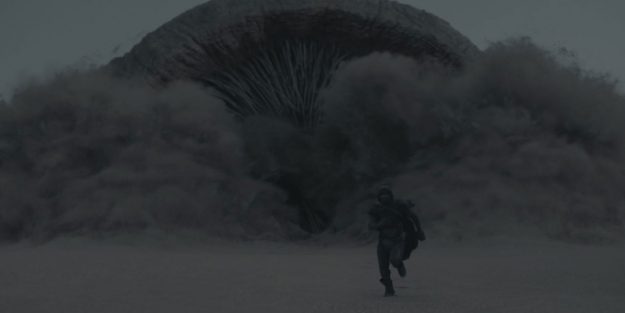With its complex tapestry of political intrigue, war, sandworms, desert messianism, and otherworldly spice, Frank Herbert’s 1965 novel Dune continues to be one of science fiction’s most influential works and an enduring pop culture phenomenon. And while the epic franchise might seem like an unlikely place to find the teachings of the Buddha, an undercurrent of Zen flows throughout.
At the heart of the novel is the planet Arrakis, also known as Dune, the exclusive source of the spice (“Melange”) that grants its users prolonged life and heightened awareness. The story unfolds against the backdrop of a millennia-spanning plan orchestrated by the Bene Gesserit sisterhood, who aim to engineer the perfect being, the Kwisatz Haderach. This prophecy finds its fulfillment in young Paul Atreides. With the house of Atreides assuming control of Arrakis, the long-running feud between Paul’s family and their sworn enemy, the Harkonnens, comes to a head. Bolstered by the emperor’s own troops, the Harkonnens attack the Atreides stronghold on Arrakis. As Paul begins to discover his own latent mental abilities, he escapes with his mother to the desert, where the two become entwined with the native Fremen and their messianic prophecy.

Though long thought to be unfilmable because of the complexity of its plot, the scope of its world, and the depth of its mystic vision, the story has been adapted for the silver screen by a handful of directors. In 1984, David Lynch released his version to mostly poor reviews, but it has since become a cult classic. Between 2000 and 2003, the Syfy Channel produced two miniseries of the franchise, adapting Dune and two of its sequel novels. And finally, in 2021, Denis Villeneuve released Dune: Part One, and in 2024, Dune: Part Two (together adapting the complete first novel). Both films have been well received and are considered box office hits.
So where does Buddhism enter into the picture of this desert fantasy, and how was the film’s creator first exposed to Zen?
The Spiritual Background of Frank Herbert
Born in 1920, Frank Herbert was raised by an agnostic father and a Catholic mother. This dichotomy sparked a lifelong fascination with religion. While he was still quite young, Herbert’s Catholic maternal aunts “attempted to force religion on him,” an attempt he resisted. Finally, at the urging of his father, his aunts relented. Later on, his aunts would become the model for the Bene Gesserit (as hinted at in the similarity of pronunciation between “Gesserit” and “Jesuit”).

In the years prior to envisioning Dune, Herbert had three main encounters with Zen Buddhism. In an account from his older son, Brian Herbert, from his 2003 biography, Dreamer of Dune: The Biography of Frank Herbert, Herbert grew up among many second-generation Japanese Americans living in Washington State, many of whom were Zen Buddhists. Several years later, he made the acquaintance of Ralph and Irene Slattery, an eclectic psychologist and Jungian analyst, respectively, whose collective interests included existentialism, phenomenology, and Zen Buddhism.
In 1959, Herbert began compiling notes in preparation for writing Dune. These dealt with sand dune formation, ecology, desert religion, and Zen. It was during this research period that Herbert was introduced to the works of Alan Watts, one of Zen Buddhism’s early Western evangelists, and the two struck up an amicable friendship. In Dreamer, Brian Herbert states that even prior to meeting the English Zen advocate, Frank Herbert had “read every word Watts had ever written, and had made extensive notes from these and other Zen [writings] for his desert novel.”
In a 1963 interview with American literature professor and writer Willis E. McNelly, Herbert himself claimed that he didn’t “profess a religion” but that he believed “more in self-development in the Zen sense.”
A Zen-Anchored Amalgam
Many layers of Zen Buddhist influence are found within the pages of Dune. The most famous example can be found in the novel’s “Litany Against Fear.” It is a mind-training technique taught to Paul by his mother, herself a Bene Gesserit. The litany goes:
“I must not fear.
Fear is the mind-killer.
Fear is the little-death that brings total obliteration.
I will face my fear.
I will permit it to pass over me and through me.
And when it has gone past, I will turn the inner eye to see its path.
Where the fear has gone there will be nothing.
Only I will remain.”
This is an example of the syntheses of “Mahayana Christianity” and “Zensunni Catholicism” that Herbert discusses in the appendixes to the novel. Paul uses this technique to cleanse the mindstream of fear, treating it as a klesha, or a mental defilement. This is standard practice in Buddhism. And yet, when he “turn[s] the inner eye to see,” he doesn’t find the emptiness of self, the absence of permanence hidden within, as one would expect. Instead, he sees that “only I will remain.” The “I,” or the self, here is given a more prominent role than typically seen in Buddhism. It holds closer to the Christian teachings of Herbert’s youth.

However, in contrast, earlier in the novel, Herbert gives us a window into Paul’s psyche, when we see Paul’s mind training as if given a sci-fi-tinged guided meditation. Herbert writes:
“Paul sensed his own tensions, decided to practice one of the mind-body lessons his mother had taught him. Three quick breaths triggered the responses: he fell into floating awareness … the human requires a background grid through which to see his universe … focused consciousness by choice, this forms your grid … all things/cells/beings are impermanent …strive for flow-permanence within…”
Here, Paul experiences a negative sensation and responds to it by controlling his breath. This causes him to fall into “floating awareness,” no longer identified with the six senses (the five standard senses and the sixth, mind sense). He understands that we all need “a background grid through which to see the universe.” This is the conceptual map we use to navigate the world. Without it, we’d be unable “to see the universe,” since it’s populated with the objects, ideas, and people (all dharmas) that are cocreated with our minds. The sticking point is that we often believe these dharmas exist intrinsically, that they possess little kernels of selfhood that never change. And we often routinely believe the same about ourselves. The antidote to this misperception is the realization that “all things/cells/beings are impermanent…” If all the pieces of our conceptual map are ever-changing and impermanent, then there’s nothing to hold on to, including ourselves. To “strive for flow-permanence within” means the only permanence is impermanence. Everything in the universe flows like water: air, earth, plants, buildings, cities, nations, even ourselves.
And so Herbert leaves us with the dichotomy of “only I will remain” and “all things … are impermanent,” a juxtaposition often grappled with by Zen students in the modern world, where Christianity and Zen often sit side by side.
In the second half of the novel, or near the end of the film Dune: Part Two, Paul takes the Water of Life. This is the culmination of the Bene Gesserit’s breeding program to create a superhuman, the Kwisatz Haderach, who they’d hoped would usher in a more peaceful and prolonged era for humanity. Paul says:
“There is in each of us an ancient force that takes and an ancient force that gives. A man finds little difficulty facing that place within himself where the taking force dwells, but it’s almost impossible for him to see into the giving force without changing into something other than man. For a woman, the situation is reversed.”
In the previous passage, we hear echoes of that seminal Zen text the Xinxin Ming (Verses on the Faith-Mind): “As long as you remain in one extreme or the other / you will never know Oneness.” To find the Middle Way between extremes, to neither cling, push away, nor ignore all the phenomena of our lives, that is how we end dukkha—suffering and dissatisfaction. However, we also hear echoes of the Bahudhātuka Sutta, where it’s stated: “It’s impossible for a woman to be a perfected one, a fully awakened Buddha. But it is possible for a man to be a perfected one, a fully awakened Buddha.” When Paul takes the Water of Life, we get a peek into Herbert’s ingrained patriarchal views on spiritual development, which reflects a subtext of gender bias layered throughout many Buddhist texts and organized religious traditions. Yet it is Paul’s unique identity as the sole male Bene Gesserit, a member of an exclusive sisterhood, that identifies him as the Kwisatz Haderach, with access to all of their skills and powers. He is not one, not two, but nondual, masculine and feminine, a coalescence, and in this revelation, Herbert sets up Paul’s ability to take emptiness to its final conclusion.
In the end, Paul gains his pivotal insight, clear light awareness, or enlightenment as experienced in the world of Dune: “I’ve seen the Now.” Whereas the various mystical factions in the novel have a great command of the past and limited insight into the future, Paul can easily see both. But his greatest insight was to see the Now, to peer fully into this very moment and unite all three time periods. This recalls Dogen Zenji’s teachings of Uji (Being-Time), where “so-called today flows into tomorrow, today flows into yesterday, yesterday flows into today.” The past, present, and future are all right here, right now. To realize this is to be liberated from all three.
Although there are undercurrents and overcurrents of many religions and meta-myths present in Dune, Zen Buddhism may have been the closest to Frank Herbert’s heart. The examples given here are only a few of the many instances of the tradition’s influence on the epic novel. And while practitioners will easily be able to identify many elements of Buddhism threaded throughout, the novels don’t explicitly set out to introduce or indoctrinate readers into the world of Zen. In Dune, the First Law of Mentat—or advanced spiritual practitioner—states: “A process cannot be understood by stopping it. Understanding must move with the flow of the process, must join it and flow with it.” Rather than stop you in your tracks, the Zen underpinnings of Dune are supposed to be felt, not dissected, and it is perhaps in this quality that Herbert understood the teachings the most.
Thank you for subscribing to Tricycle! As a nonprofit, we depend on readers like you to keep Buddhist teachings and practices widely available.
